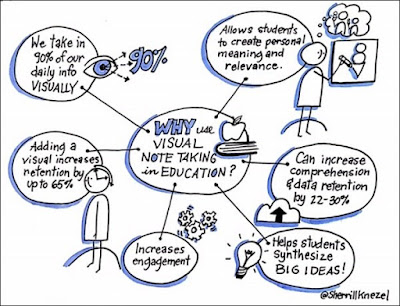 |
| Photo: Sherrill Knezel |
 |
| Photo: Sherrill Knezel |
A previous generation referred to this form of notetaking as doodling, but that is starting to change. One reason this effective tool—which uses a combination of images and text to make meaning of verbal or text-based information—hasn’t made its way into many teachers’ hands is that the data-driven testing craze has usurped the time and energy to explore or try any new creative literacy strategies. With new math and reading curricula rolled out frequently, districts barely have time to train teachers the basics, much less explore creative literacy tools.
I decided to affect change within my immediate circle of influence and utilize these visual skills on a daily basis with my elementary art students. For the past two years, I have offered professional development workshops on visual notetaking and literacy to colleagues in my district to increase awareness of this literacy tool. These collaborations span across content areas and grade levels—with teachers in special education, teachers in social studies, and teachers in elementary through high school.
The Science of Memory
The success of visual notetaking is backed by science. The Picture Superiority Effect refers to the phenomenon that we remember pictures better and longer than words or text. If students read text alone, three days later they only remember 10 percent of the information—but adding a picture to the text increases recall to 65 percent. And dual-coding theory says that our brains process and store visual information differently than verbal or text-based information. When students use images and text in notetaking, it gives them two different ways to pull up the information, doubling their chances
of recall.
Yet, when I first learned about visual notes, a teacher in my building made a student redo multiple worksheets for "doodling" in the margins, and other students would echo that they would get in trouble with their teacher for drawing.
Why aren’t more teachers providing students with this option? And just as importantly, why are students actually being reprimanded for their natural instinct to record ideas visually?
Read more...
Source: Education Week










